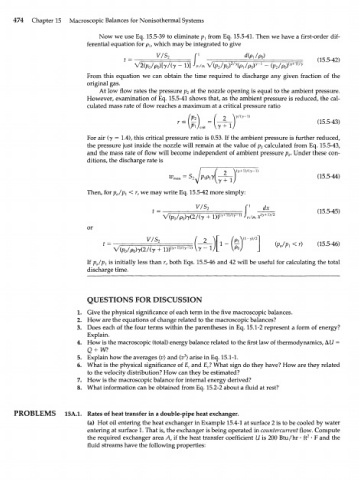Page 494 - Bird R.B. Transport phenomena
P. 494
474 Chapter 15 Macroscopic Balances for Nonisothermal Systems
Now we use Eq. 15.5-39 to eliminate р л from Eq. 15.5-41. Then we have a first-order dif-
ferential equation for p v which may be integrated to give
* " ? П5.5-42»
V2(p / )ly/(y - •1>/y
o Po
From this equation we can obtain the time required to discharge any given fraction of the
original gas.
At low flow rates the pressure p at the nozzle opening is equal to the ambient pressure.
2
However, examination of Eq. 15.5-41 shows that, as the ambient pressure is reduced, the cal-
culated mass rate of flow reaches a maximum at a critical pressure ratio
(15.5-43)
For air (y = 1.4), this critical pressure ratio is 0.53. If the ambient pressure is further reduced,
the pressure just inside the nozzle will remain at the value of p calculated from Eq. 15.5-43,
2
and the mass rate of flow will become independent of ambient pressure p . Under these con-
0
ditions, the discharge rate is
V 9 \(y+D/(y-l)
Then, for p /p\ < r, we may write Eq. 15.5-42 more simply:
a
V( /p )y(2/(y •
o
Po
or
v/s
2 r
tyJV\ < ) (15.5-46)
If p lp\ is initially less than r, both Eqs. 15.5-46 and 42 will be useful for calculating the total
a
discharge time.
QUESTIONS FOR DISCUSSION
1. Give the physical significance of each term in the five macroscopic balances.
2. How are the equations of change related to the macroscopic balances?
3. Does each of the four terms within the parentheses in Eq. 15.1-2 represent a form of energy?
Explain.
4. How is the macroscopic (total) energy balance related to the first law of thermodynamics, ALJ =
Q+ W?
3
5. Explain how the averages (v) and (v ) arise in Eq. 15.1-1.
6. What is the physical significance of E and E ? What sign do they have? How are they related
v
c
to the velocity distribution? How can they be estimated?
7. How is the macroscopic balance for internal energy derived?
8. What information can be obtained from Eq. 15.2-2 about a fluid at rest?
PROBLEMS 15A.1. Rates of heat transfer in a double-pipe heat exchanger.
(a) Hot oil entering the heat exchanger in Example 15.4-1 at surface 2 is to be cooled by water
entering at surface 1. That is, the exchanger is being operated in countercurrent flow. Compute
2
the required exchanger area A, if the heat transfer coefficient U is 200 Btu/hr • ft • F and the
fluid streams have the following properties:

